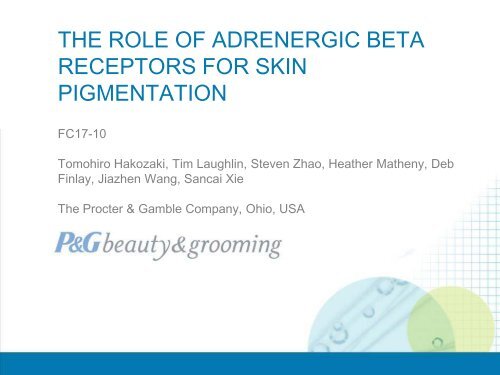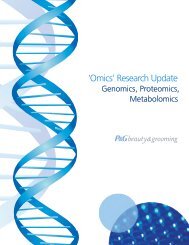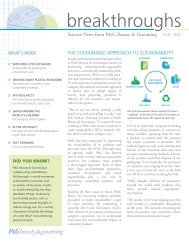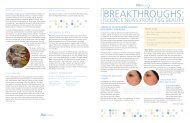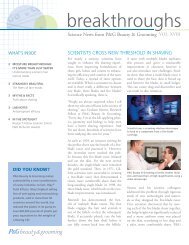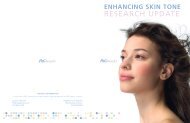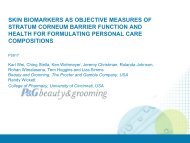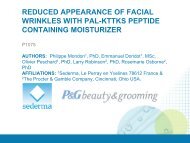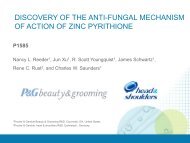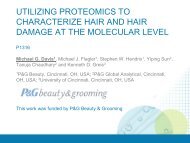the role of adrenergic beta receptors for skin pigmentation
the role of adrenergic beta receptors for skin pigmentation
the role of adrenergic beta receptors for skin pigmentation
Create successful ePaper yourself
Turn your PDF publications into a flip-book with our unique Google optimized e-Paper software.
THE ROLE OF ADRENERGIC BETA<br />
RECEPTORS FOR SKIN<br />
PIGMENTATION<br />
FC17-10<br />
Tomohiro Hakozaki, Tim Laughlin, Steven Zhao, Hea<strong>the</strong>r Ma<strong>the</strong>ny, Deb<br />
Finlay, Jiazhen Wang, Sancai Xie<br />
The Procter & Gamble Company, Ohio, USA
Introduction:<br />
Changes in facial attributes by age<br />
10 yrs<br />
30 yrs 50 yrs<br />
10 yrs<br />
<br />
<br />
As we age facial <strong>skin</strong> attributes change<br />
Hyperpigmented spots increase with age
Senile Lentigo – Typical Hyperpigmented Spot<br />
Increasing by Age<br />
Skin appearance<br />
Normal <strong>skin</strong><br />
Senile Lentigo<br />
Number <strong>of</strong> melanocytes<br />
Rete Ridge on Senile Lentigo
Objectives<br />
• Compare <strong>the</strong> gene expression patterns between age<br />
spots (solar lentigines) vs. adjacent <strong>skin</strong> using gene chip<br />
microarrays<br />
• Investigate <strong>the</strong> <strong>role</strong> <strong>of</strong> <strong>adrenergic</strong> <strong>receptors</strong> <strong>for</strong> <strong>skin</strong><br />
<strong>pigmentation</strong><br />
• Screen ingredients <strong>for</strong> <strong>the</strong>ir ability to down-regulate <strong>the</strong><br />
<strong>adrenergic</strong> receptor <strong>beta</strong> pathway
Senile Lentigo Genomics Study Design<br />
Normal <strong>skin</strong><br />
Senile Lentigo<br />
• 9 females (39-76 yrs) who<br />
has solar lentigo on<br />
back/arm<br />
• Take biopsy from senile<br />
lentigo and adjacent<br />
normal <strong>skin</strong><br />
• Genomics analysis with<br />
Affymetrix Genechips<br />
Affymetrix Genechips<br />
Biopsy<br />
Biopsy<br />
RNA<br />
RNA
46,000 gene expression data
Adrenergic Receptors<br />
Up-regulated Genes in Solar Lentigo Skin<br />
Acr Title Fold change spot vs. normal P-value<br />
ADRB1 Adrenergic Receptor <strong>beta</strong>-1 14.5 0.044<br />
• Adrenaline – related to stress deeply, a<br />
hormone, increases heart rate, contracts<br />
blood vessels, etc.<br />
• Adrenergic receptor - 2 main groups, α<br />
and β, with several subtypes<br />
• Adrenergic Receptor <strong>beta</strong>-2 antagonist<br />
accelerates <strong>skin</strong> barrier recovery and<br />
reduces epidermal hyperplasia induced<br />
by barrier disruption (JID 2003)<br />
• Adrenergic Receptor <strong>beta</strong>-2 UVB<br />
irradiation increases adrenaline release<br />
by keratinocytes, which can streng<strong>the</strong>n<br />
melanin syn<strong>the</strong>sis (JID 2008)<br />
Reference; wikipedia
Beta-<strong>adrenergic</strong> receptor agonists stimulated<br />
melanin syn<strong>the</strong>sis in B16 melanoma cells<br />
• Beta <strong>adrenergic</strong> agonists (dobutamine, isoprenaline) stimulated<br />
melanin syn<strong>the</strong>sis in melanoma B16 cells, when cultured to<br />
confluency and syn<strong>the</strong>sizing sufficient melanin to detect with a<br />
simple spectrophotometric assay.<br />
Melanin Syn<strong>the</strong>sis Activity with Beta Adrenergic Agonists in B16<br />
Melanoma Cells (%control)<br />
Melanin amount [% vs. control]<br />
300<br />
250<br />
200<br />
150<br />
100<br />
50<br />
dobutamine (<strong>beta</strong>-1 agonist)<br />
Isoprenaline (<strong>beta</strong>-1&2 agonist)<br />
0<br />
0.000001 0.00001 0.0001 0.001 0.01<br />
w/v %
Dobutamine (ADR <strong>beta</strong>-1 agonist) up-regulated<br />
<strong>pigmentation</strong> related gene transcription<br />
in human ex vivo tissue<br />
Dobutamine stimulated <strong>pigmentation</strong> related gene expression<br />
Fold change vs. control<br />
14<br />
12<br />
10<br />
8<br />
6<br />
4<br />
2<br />
*<br />
*<br />
*<br />
*<br />
Control<br />
Dobutamine 0.001%<br />
Dobutamine 0.01%<br />
*<br />
*<br />
0<br />
* sig vs. control (p
Investigating <strong>the</strong> function <strong>of</strong> Adrenergic Receptor (ADR)<br />
– applying siRNA technique to B16 melanoma cells<br />
• Knocked down 9 ADR genes with siRNA and measure melanin syn<strong>the</strong>sis<br />
in B16 melanoma cell<br />
Melanocyte<br />
melanosome<br />
Ø<br />
Melanin Production<br />
Genome<br />
Nucleus<br />
ADR<br />
mRNA<br />
Small interfering (si) RNA<br />
<strong>for</strong> <strong>adrenergic</strong> receptor<br />
genes interfere ADR gene<br />
expression
ADR series knockout leads to reducing melanin<br />
production in B16 melanoma cells<br />
Effect <strong>of</strong> Specific Adrenergic Receptor Knockdown by siRNA in B16 Melanin Production<br />
Reduce Melanin Syn<strong>the</strong>sis<br />
% Knockdown <strong>of</strong> melanin production vs. control .<br />
100<br />
80<br />
60<br />
40<br />
20<br />
0<br />
-20<br />
-40<br />
-60<br />
78<br />
26 28 30<br />
ADRA1A<br />
ADRA1B<br />
ADRA1D<br />
ADRA2A<br />
25<br />
ADRA2B<br />
Over-expressed<br />
in solar<br />
lentigo<br />
69<br />
63<br />
53<br />
ADRA2C<br />
ADRB1<br />
ADRB2<br />
ADRB3<br />
-47<br />
90<br />
Tyrosinase
Screening <strong>of</strong> Adrenergic Receptor Beta Antagonist<br />
Using a Recombinant GPCR Cell Line<br />
• Beta-arrestin plat<strong>for</strong>m utilizing a recombinant GPCR cell line (CHO cells)<br />
• Takes advantage <strong>of</strong> <strong>the</strong> property that activated GPCRs recruit <strong>beta</strong>-arrestin a<br />
shutdown mechanism. The GPCR is expressed as a fusion protein with a small<br />
piece <strong>of</strong> <strong>beta</strong>-galactosidase on <strong>the</strong> cytoplasmic side.<br />
• Beta-arrestin is also expressed as a fusion protein with <strong>the</strong> remainder <strong>of</strong> <strong>the</strong> <strong>beta</strong><br />
galactosidase enzyme. Upon recruitment <strong>of</strong> <strong>beta</strong>-arrestin, <strong>the</strong> <strong>beta</strong>-galactosidase<br />
pieces are united to <strong>for</strong>m an active enzyme, which is detectable with a substrate<br />
mixture that produces a luminescent signal with <strong>beta</strong>-galactosidase action.
Screening <strong>of</strong> ADRB Antagonist<br />
Undecylenoyl Phenylalanine works as an antagonist <strong>of</strong> ADRB1 & 2<br />
N-undecyl-10-L-phenylalanine<br />
Effect <strong>of</strong> Undecylenoyl Phenylalanine<br />
on Adrenergic Receptor B1<br />
Effect <strong>of</strong> Undecylenoyl Phenylalanine<br />
on Adrenergic Receptor B2<br />
100<br />
90<br />
120<br />
% Inhibition vs. control<br />
80<br />
70<br />
60<br />
50<br />
40<br />
30<br />
20<br />
10<br />
0<br />
1.44E-05 0.00036 0.009 0.045<br />
Undecylenoyl Phenylalanine concentration [%]<br />
% inhibition vs. control<br />
100<br />
80<br />
60<br />
40<br />
20<br />
0<br />
0.0003 0.0009 0.0028 0.0084<br />
Undecylenoyl Phenylalanine concentration [%]
Topical application <strong>of</strong> 1% Undecylenoyl Phenylalanine<br />
containing moisturizer reduced melanin amount in<br />
ex vivo human tissue model<br />
1% Undecylenoyl Phenylalanine-containing Moisturizer<br />
Reduces Melanin Amount in Human Skin Explant Model<br />
Melanin amount measured by image analysis <strong>of</strong><br />
stained cross-sectional images (day 6)<br />
800<br />
700<br />
600<br />
500<br />
400<br />
300<br />
200<br />
100<br />
0<br />
1% UP in Vehicle Vehicle moisturizer<br />
• Tissue from abdominal, Skin type III, Tissue was cultured with treatment <strong>for</strong> 6 days, N=6 samples <strong>for</strong> each
ADRB Signaling Pathway in Melanocyte<br />
• Adrenergic <strong>receptors</strong> <strong>beta</strong>-1 and -2 intersect a known <strong>pigmentation</strong> pathway at cAMP production caused<br />
by activated Gs Protein. The cascade proceeds downstream to MITF upregulation which turns on<br />
<strong>pigmentation</strong> related gene expressions including tyrosinase.<br />
Keratinocyte<br />
Adrenaline<br />
Cytokines<br />
Keratinocyte<br />
alpha-MSH<br />
Endo<strong>the</strong>lin-1<br />
SCF<br />
Melanosome<br />
transfer<br />
Undecyleno<br />
yl<br />
Phenylalan<br />
ine<br />
X<br />
ADRB1/2<br />
MC1R<br />
cAMP<br />
ETR<br />
PKC<br />
PKA<br />
c-kit<br />
MAP kinase<br />
Melanin syn<strong>the</strong>sis↑<br />
Melanocyte
Evaluation <strong>of</strong> Undecylenoyl Phenylalanine Effect on Facial<br />
Hyper-pigmented Spots in Human Clinical Study<br />
Product<br />
Design<br />
Subject<br />
Measure<br />
• Vehicle moisturizer<br />
• 1% Undecylenoyl phenylalanine containing <strong>for</strong>mula in Vehicle<br />
• 5% Niacinamide containing <strong>for</strong>mula in Vehicle (control)<br />
• Split face, round robin design<br />
• Double blinded, left-right randomized, vehicle controlled<br />
• 8 weeks product treatment period (0, 4, 8 week visits)<br />
• Females having moderate hyperpigmented spots symmetrically on<br />
both sides <strong>of</strong> <strong>the</strong> face<br />
• 25-60 years<br />
• 110 observations per treatment<br />
• Capture facial images followed by computer image analysis <strong>for</strong> spot<br />
area and <strong>skin</strong> color
Computer image analysis to detect hyperpigmented spots<br />
Captured facial image and ma<strong>skin</strong>g area<br />
(shown in green)<br />
Detected hyperpigmented spot area<br />
(shown in white)
Topical application <strong>of</strong> 1% Undecylenoyl Phenylalanine containing<br />
moisturizer reduced facial hyperpigmented spot appearance among<br />
Chinese females vs. its vehicle moisturizer<br />
• Both undecylenoyl phenylalanine (UP)-containing moisturizer and Niacinamidecontaining<br />
moisturizer significantly reduced appearance <strong>of</strong> facial spot compared to<br />
Vehicle (p
Conclusions<br />
• A series <strong>of</strong> in vitro and ex vivo studies demonstrated that<br />
Adrenergic <strong>receptors</strong> <strong>beta</strong> 1 and 2 play a key <strong>role</strong> in melanogenesis<br />
and potentially <strong>for</strong> age spot <strong>for</strong>mation<br />
• Undecylenoyl phenylalanine works effectively to suppress<br />
melanogenesis via down-regulating <strong>the</strong> <strong>adrenergic</strong> receptor <strong>beta</strong><br />
pathway in vitro<br />
• An Undecylenoyl phenylalanine moisturizer reduced <strong>the</strong><br />
appearance <strong>of</strong> facial hyperpigmented spots in a clinical study<br />
Acknowledgements<br />
• University <strong>of</strong> Cincinnati <strong>for</strong> solar lentigo samples<br />
• This work was funded by P&G Beauty & Grooming
This work was funded by P&G Beauty & Grooming


